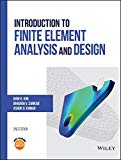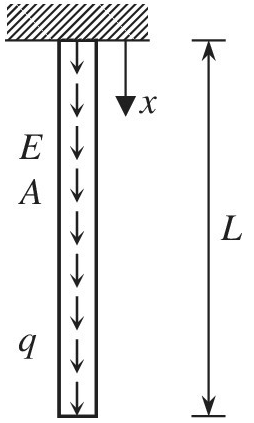
Concept explainers
A bar in the figure is under the uniformly distributed load q due to gravity. For a linear elastic material with Young’s modulus E and uniform cross-sectional area A, the governing differential equation can be written as
a. Starting from the above differential equation, derive an integral equation using the Galerkin method.
b. Write the expression of boundary conditions at
c. Derive the assembled finite element matrix equation, and solve it after applying boundary conditions.

Want to see the full answer?
Check out a sample textbook solution
Chapter 2 Solutions
Introduction To Finite Element Analysis And Design
- The wall (thickness L) of a furnace is comprised of brick material (thermal conductivity, k = 0.2 Wm¯' K'). Given that the atmospheric temperature is 0°C at both sides of wall, the density (p) and heat capacity (c) of the brick material are 1.6 gm cm³ and 5.0 J kg K¯l respectively. du Solve pc = k- subject to initial conditions as u(x,0) = x²(L – x). ốt Consider the case 2=- p² only.arrow_forwardQuestion 2: Air at the temperature of T1 is being heated with the help of a cylindrical cooling fin shown in the figure below. A hot fluid at temperature To passes through the pipe with radius Rc. a) Derive the mathematical model that gives the variation of the temperature inside the fin at the dynamic conditions. b) Determine the initial and boundary conditions to solve the equation derived in (a). air To Re Assumptions: 1. Temperature is a function of only r direction 2. There is no heat loss from the surface of A 3. Convective heat transfer coefficient is constantarrow_forward1. Three springs, A, B and C, are connected as shown below, with one end of A and C attached to rigid supports. All springs are interconnected by a light, inextensible bar that is constrained from rotating. Also, forces of 250 N and 175 N are applied to the springs as shown. The stiffness of A, B and C are 100, 150 and 200 N/mm, respectively. By modelling each spring as a linear simplex finite element, determine: (a) (b) (c) the global assembly the elongation of the springs the reactions at the supports (Ans: (b) u, = 1.417 mm, u, = 1.667 mm, uc = 11.417 mm (c) Ren = 141.67 N, left, Riaht = 283.33 N, left) B 250 N wwww-→ A 175 Narrow_forward
- Instead of 0.q, you have to use my student ID using the last 3 digits. If the last 3 digits of my student ID are 495.q use 495 instead. Question 2: Equivalent Nodal Forces of 2-D Plane Finite Elements ( For the four-node linear plane element shown below with a uniform surface traction along its side 2-3. You are required to evaluate the force matrix by using the energy equivalent nodal forces. Let the thickness of the element be t= 10 + 0.q mm. T = 20 + 0.q N/mm2 (0, 4) (5, 4) (0, 0) (8, 0) 1 2arrow_forwarda. A slab of thermal insulator is 100 cm² in cross section and 2 cm thick. Its thermal conductivity is 2.4 x 10 -+ cal/(s cm C"). If the temperature difference between opposite faces is 180 F', how much heat flows through the slab in one day?arrow_forwardA thin flexible gold chain of uniform linear density has a mass of 17.5 g. It hangs between two 30.0 cm long vertical sticks (vertical axes) which are a distance of 30.0 cm apart horizontally (x-axis), as shown in the figure below which is drawn to scale. Evaluate the magnitude of the force on the left hand pole. 30 28 26 24 22 20 18 16 14 12 10 8 6 4 2 0 0 2 4 6 58 10 12 14 16 18 20 22 24 26 28 30arrow_forward
- Consider the following linear equations,arrow_forward(3) For the given boundary value problem, the exact solution is given as = 3x - 7y. (a) Based on the exact solution, find the values on all sides, (b) discretize the domain into 16 elements and 15 evenly spaced nodes. Run poisson.m and check if the finite element approximation and exact solution matches, (c) plot the D values from step (b) using topo.m. y Side 3 Side 1 8.0 (4) The temperature distribution in a flat slab needs to be studied under the conditions shown i the table. The ? in table indicates insulated boundary and Q is the distributed heat source. I all cases assume the upper and lower boundaries are insulated. Assume that the units of length energy, and temperature for the values shown are consistent with a unit value for the coefficier of thermal conductivity. Boundary Temperatures 6 Case A C D. D. 00 LEGION Side 4 z episarrow_forwardh = 0.25 solve for the differential equation y (1) h take and calculate approximately with Euler's method.arrow_forward
- Calculate the stiffness matrix for the Q8 element shown below. Make use of the shape functions in natural coordinates and the Jacobian calculated in previous problems. Use 2x2 Gaussian numerical integration. Use plane strain conditions (for unit thickness) with E=200E9 (MPa) and nu=0.25. I have attached my matlab code below. Please look thru it and correct it. Thanks. u=sym('u') %%ztav=sym('v') %%eta x1=1x2=2x3=3.5x4=3.6x5=4.0x6=2.3x7=1.2x8=0.8 y1=1y2=1y3=1.3y4=2.3y5=3.3y6=3.2y7=3.0y8=2.0X=[x1;x2;x3;x4;x5;x6;x7;x8]Y=[y1;y2;y3;y4;y5;y6;y7;y8]%% diff of ztaDN1Du=1/4*(1-v)*(2*u+v);DN2Du=-u*(1-v);DN3Du=1/4*(1-v)*(2*u-v);DN4Du=1/2*(1-v^2);DN5Du=1/4*(1+v)*(2*u+v);DN6Du=-u*(1+v);DN7Du=1/4*(1+v)*(2*u-v);DN8Du=-1/2*(1-v^2); %% diff of etaDN1Dv=1/4*(1-u)*(2*v+u);DN2Dv=-1/2*(1-u^2);DN3Dv=1/4*(1+u)*(2*v-u);DN4Dv=-v*(1+u);DN5Dv=1/4*(1+u)*(2*v+u);DN6Dv=1/2*(1-u^2);DN7Dv=1/4*(1-u)*(2*v+u);DN8Dv=-v*(1-u);%% find dx/du dx/dv, dy/du and dy/dva=[DN1Du, DN2Du, DN3Du, DN4Du, DN5Du, DN6Du,DN7Du,…arrow_forward7. Consider an element that conducts heat as shown below with length L, cross sectional area A, and heat conductance k. Nodes 1 and 2 have temperatures of T, and T2. The heat flux q due to conduction is given by: dT ΔΤ q = - k dx Ax This relationship is analogous to Hooke's Law from the prior problem. Heat transfer by conduction Qc is given by: Oc = qA Use equilibrium requirements to solve for the heat transfer by conduction Qci and Qcz at the nodes and use these equations to derive a "conductance matrix" (or the stiffness matrix due to conduction which is the analog of the stiffness matrix) for this heat conducting element. For the sign convention, consider heat flux positive when heat flows into the element and negative when it flows out of the element. Show your full matrix equation and the conductance matrix. Oci T T2 Oc2 2arrow_forwardFind the temperature at the interior node given in the following figure 100 °C 75 °C 0 °C 9" %3D 25 °C 6" Using the Lieberman method and relaxation factor of 1.2, the temperature estimated after first iterations is: Select one: а. 60.00 b. 45.19 С. 50.00arrow_forward
 Principles of Heat Transfer (Activate Learning wi...Mechanical EngineeringISBN:9781305387102Author:Kreith, Frank; Manglik, Raj M.Publisher:Cengage Learning
Principles of Heat Transfer (Activate Learning wi...Mechanical EngineeringISBN:9781305387102Author:Kreith, Frank; Manglik, Raj M.Publisher:Cengage Learning
